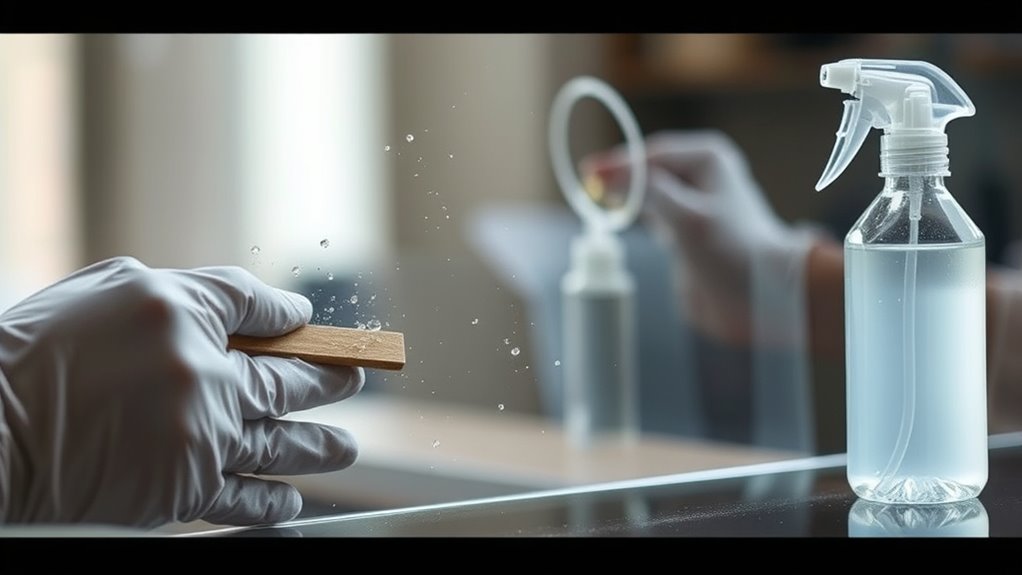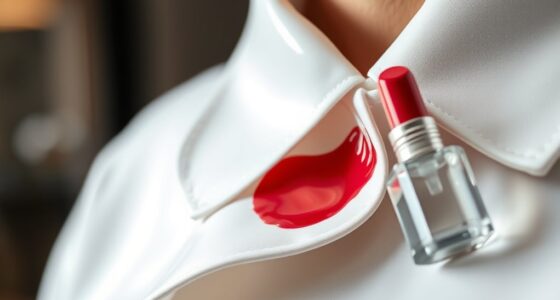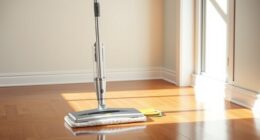To remove adhesive residue from glass surfaces, start by cleaning the area with a mild glass cleaner. Then, apply solvents like vinegar or acetone to the residue. Use a plastic scraper or credit card to gently scrape away the adhesive, being careful not to scratch the glass. Finally, clean the glass again for a streak-free finish and inspect for any remaining residue. If you need more tips on effective removal techniques, there’s plenty more to explore.
Key Takeaways
- Start by cleaning the glass with a mild glass cleaner to remove dirt and debris before tackling the adhesive residue.
- Apply effective solvents like vinegar or acetone to soften the adhesive, ensuring good ventilation while using gloves and safety goggles.
- Gently scrape off the softened adhesive with a plastic scraper or credit card, holding tools at a low angle to prevent scratching.
- Soak the adhesive area with a warm washcloth to aid in removal, and repeat if any stickiness remains after initial cleaning.
- Always practice safety by wearing protective gear, ensuring proper ventilation, and washing hands thoroughly after handling cleaning chemicals.
Understanding Adhesive Residue
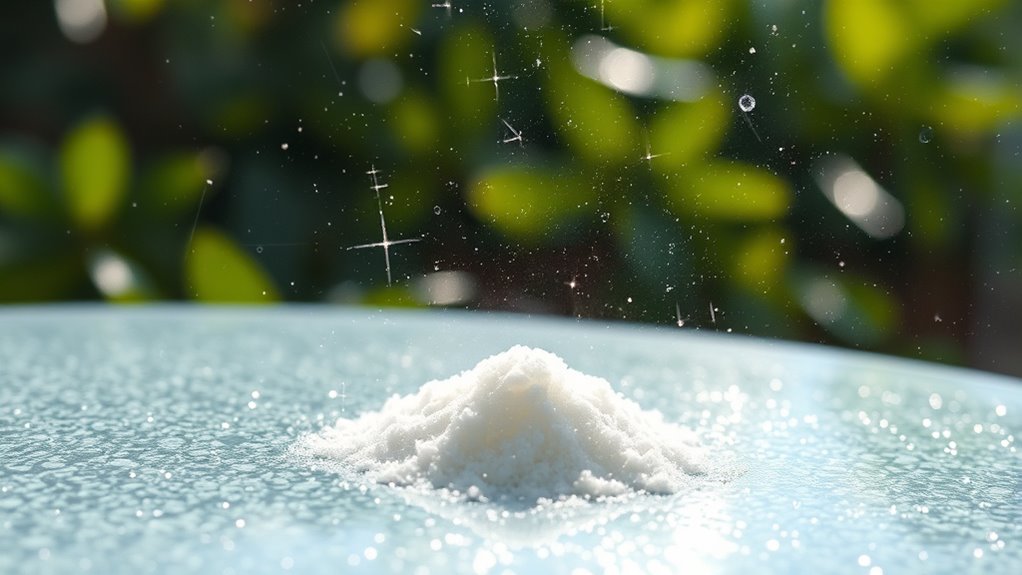
Adhesive residue can be a frustrating issue when it clings to glass surfaces. These residues come from various sources like stickers, labels, and tapes, forming strong bonds that are tough to remove. The longer the adhesive stays on the glass, the harder it becomes to eliminate. Plus, this residue can attract dust and dirt, making your glass look dirty and unkempt. Different adhesives have unique compositions, which influence their stickiness and ease of removal. Environmental factors, like temperature and humidity, also play a role in how well the adhesive clings. Understanding these aspects is essential for effectively tackling adhesive residue and maintaining the clarity and cleanliness of your glass surfaces. Additionally, many commercial adhesives used on glass are made of acrylic, rubber, or silicone, which contributes to their strong bonding properties.
Pre-Cleaning the Area

Before tackling adhesive residue, it’s crucial to prepare the glass surface properly. Start by cleaning the area with a mild glass cleaner to remove dirt and debris, guaranteeing a smooth application later. Use a soft, lint-free cloth to wipe the surface dry, preventing streaks and water spots. Be sure to remove any large pieces of adhesive or stickers first, as they can interfere with your cleaning process. Check that the area is free of dust, enhancing the visibility of the residue. Avoid using harsh chemicals or abrasive materials that can scratch the glass. Finally, always test cleaning products in an inconspicuous spot to verify they’re safe for your specific glass type. Additionally, consider using warm solutions to help loosen the adhesive before cleaning.
Applying Solvents

Once you’ve prepped the glass surface, it’s time to tackle the adhesive residue using solvents.
Start by choosing an effective option like vinegar, acetone, or mineral spirits. Acetone works wonders on stubborn adhesives, while mineral spirits are gentler on delicate surfaces. Rubbing alcohol evaporates quickly, leaving no residue behind, and citrus-based cleaners are natural and eco-friendly. Removing adhesive residue can be manageable with the right approach and tools.
Always guarantee good ventilation when using strong solvents, and wear gloves and safety goggles to protect yourself. Test your chosen solvent on an inconspicuous area first to guarantee compatibility with the glass.
Scraping Off Adhesive
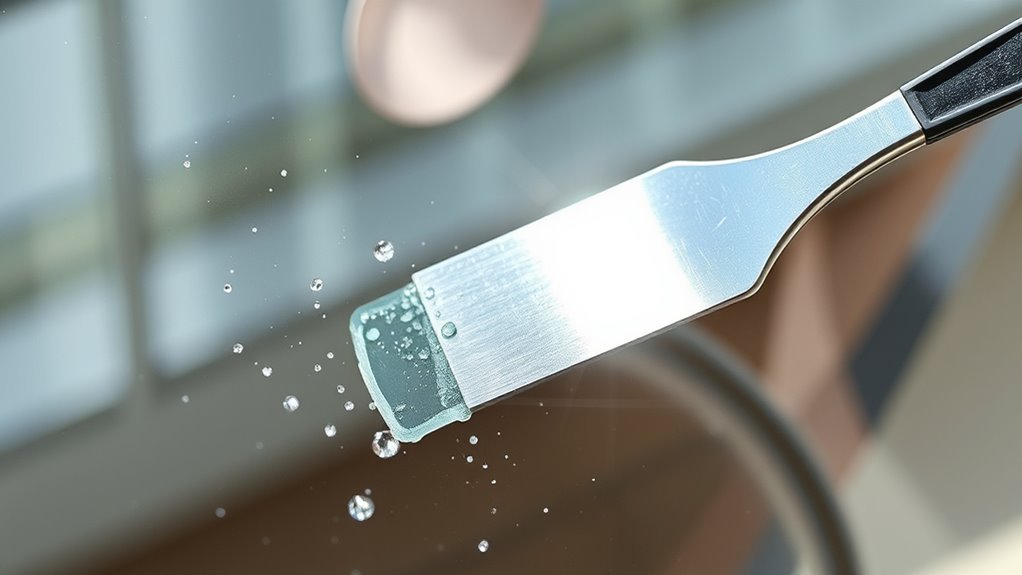
Start by gathering your scraping tools, as removing adhesive residue effectively requires the right approach.
Use a plastic scraper or a credit card for gentle scraping without scratching the glass. If you opt for a razor blade, be cautious; hold it at a low angle to prevent damage. Always apply gentle pressure and scrape away from your body for safety. Soak it with a warm washcloth can also help soften the adhesive before scraping. Scrape in one direction to avoid re-depositing residue. If the adhesive is stubborn, you may need to repeat the process. Remember, patience is key—sometimes it takes several attempts to achieve a clean surface.
Finally, after scraping, clean the glass thoroughly to remove any remaining residue and guarantee a sparkling finish.
Additional Removal Techniques
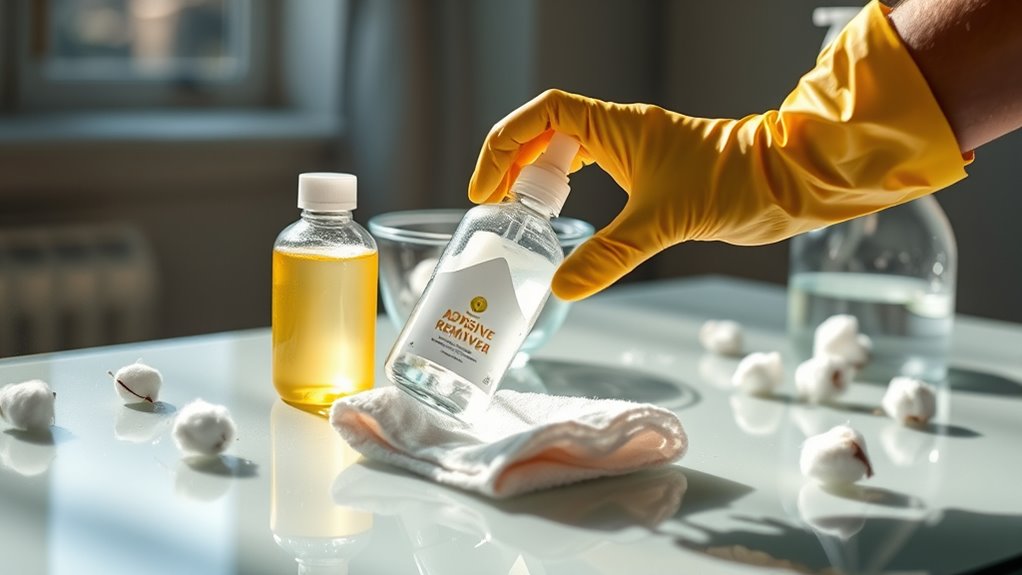
After scraping off the adhesive, you might still find some residue lingering on the glass. To tackle this, start by pre-cleaning the surface with a glass cleaner to eliminate dirt that could interfere with your efforts.
Next, consider applying rubbing alcohol or white vinegar to dissolve the remaining adhesive. If those don’t work, WD-40 or commercial removers like Goo Gone can be effective, as they contain oil-soluble agents that break down sticky residues. Using these products may also help prevent root rot associated with improper cleaning methods.
For a DIY approach, a baking soda paste or even peanut butter can soften the residue. Remember to test these methods in an inconspicuous area first.
Always use plastic scrapers to avoid scratching the glass and guarantee good ventilation when using chemical solvents. Gentle pressure is key to protecting your glass surface.
Final Cleaning and Inspection
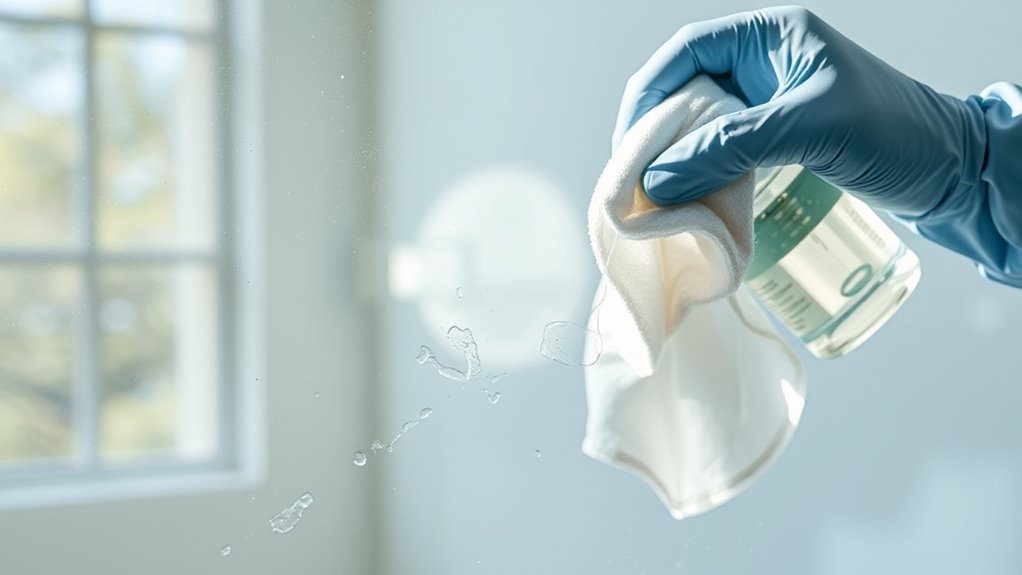
While you may have successfully removed the adhesive residue, a thorough final cleaning and inspection are essential to guarantee your glass surface is spotless.
Start by using a cleaning solution like soap and water or a vinegar-water mix to eliminate any lingering residue. For a streak-free finish, apply a product like Invisible Glass and wipe with a microfiber cloth. Additionally, quick removal of tape residue can significantly enhance the overall cleaning process.
Inspect the surface under bright light, using a magnifying glass for tiny particles. If you feel any stickiness, repeat the cleaning process.
Document your findings to refine your technique for next time. Regularly maintaining your glass not only preserves its clarity but also enhances its durability, ensuring it remains in top condition.
Tips for Preventing Residue
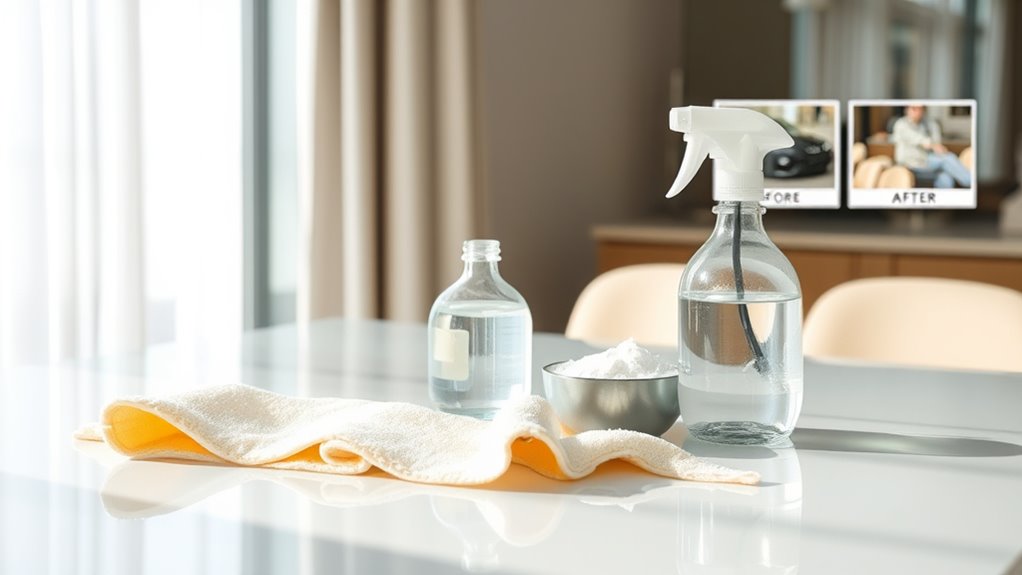
Maintaining a clean glass surface goes beyond just removing existing adhesive residue; it involves taking proactive steps to prevent residue from forming in the first place.
Start by applying stickers or labels carefully, avoiding stretching the adhesive. Always use the right adhesive for glass surfaces, and consider using removable options when possible. Additionally, using effective cleaning solutions can help remove adhesive residue before it hardens.
Don’t leave stickers on for too long; remove them as soon as they’re no longer needed. If you’re applying stickers, do so in low-humidity environments to reduce adhesive strength.
Additionally, test a small area first to verify compatibility. By following these tips, you’ll greatly minimize the chances of adhesive residue, keeping your glass surfaces looking pristine.
Safety Precautions During Removal
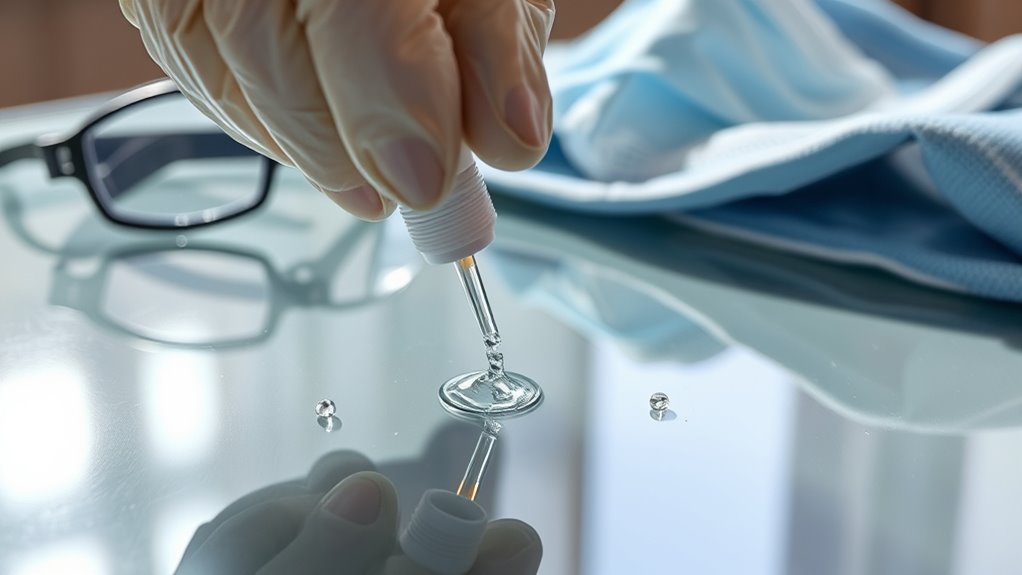
Before you start removing adhesive residue from glass, it’s essential to prioritize safety. Always wear gloves to protect your hands from chemicals and sharp edges, and use eye protection to shield your eyes from debris. Long sleeves and long pants can help guard against splashes, while closed-toe shoes protect your feet from dropped tools. Work in a well-ventilated area to avoid inhaling fumes, and keep your workspace clean to prevent accidents. When using tools, handle them carefully; opt for plastic scrapers instead of metal to reduce scratching risks. Be cautious with solvents—apply them to a cloth, not directly to the glass. Additionally, using proper techniques during the removal process can significantly reduce the risk of damaging the surface. Finally, wash your hands thoroughly after handling chemicals or sharp objects.
Frequently Asked Questions
Can I Use Vinegar on Tinted Glass Windows?
You can use vinegar on tinted glass windows, but you should be cautious.
Vinegar can dissolve adhesives, but it mightn’t be suitable for all types of window films. Some tints are sensitive to harsh chemicals, which could lead to fading or damage.
If you decide to use vinegar, dilute it with water for a gentler solution. Always test a small area first to guarantee your tint remains intact and unaffected.
How Long Should I Let Solvents Sit Before Scraping?
Imagine the patience of a gardener waiting for seeds to sprout; that’s how long you should let solvents sit.
Depending on the product, you’ll want to allow a minute or two for Invisible Glass and Lift Off, while vinegar needs 5-10 minutes to work its magic.
Rubbing alcohol and Goo Gone also benefit from a short wait.
Just remember, the longer you wait, the easier your job will be when you scrape!
Is There a Specific Temperature for Effective Adhesive Removal?
There isn’t a specific temperature for effective adhesive removal, but using heat or cold can help.
If you heat the adhesive with a hairdryer, it’ll soften, making it easier to scrape off. Conversely, applying cold with an ice cube can stiffen the adhesive, aiding in removal.
Regardless of temperature, it’s essential to act quickly while the adhesive is still fresh for the best results.
Always test your method in a small area first.
Can Adhesive Residue Damage the Glass Surface Over Time?
Adhesive residue generally won’t damage your glass surface over time.
While it might trap dirt and moisture, leading to aesthetic issues, the glass itself remains intact.
If you don’t clean the residue properly, it could result in mineral deposits or a cloudy appearance.
Regular cleaning can help maintain clarity, so don’t worry too much; just be proactive in your maintenance to keep your glass looking great!
What Alternative Methods Exist for Removing Residue Without Solvents?
If you’re stuck with sticky residue, think of it like trying to get gum off your shoe—annoying!
Luckily, there’re plenty of solvent-free methods you can try. You can use heating techniques, like a hairdryer, or apply oil, such as olive oil, to loosen it.
Also, natural options like white vinegar or baking soda paste work wonders. For physical removal, a credit card or rubber eraser can gently scrape away the residue without scratching.
Conclusion
Removing adhesive residue from glass is like clearing a foggy window to let in the light. By following the steps to clean and inspect, you not only restore clarity to your surface but also to your space. Remember, just as you wouldn’t want lingering shadows in your view, you can prevent future residue by being mindful of what you stick. Embrace the clarity that comes with a little effort, and let your surroundings shine brightly.
